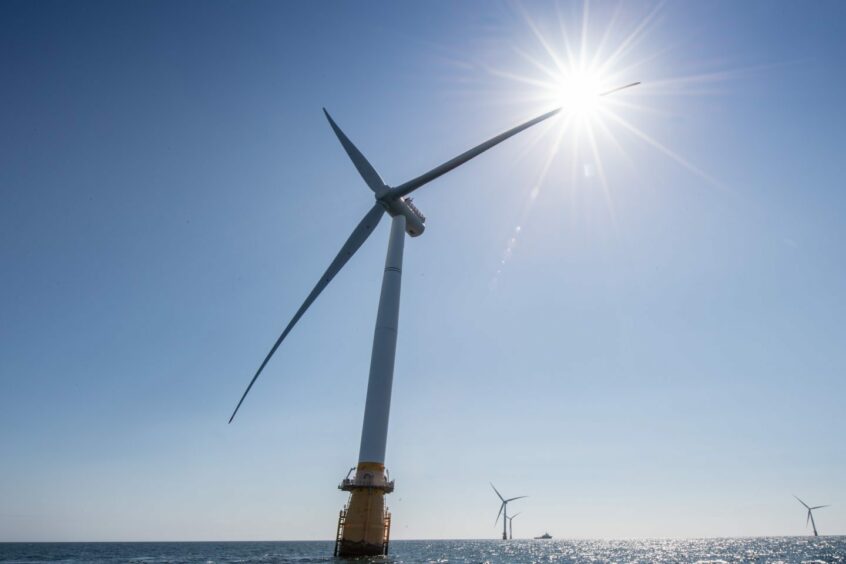
The energy sector is certainly changing. Analogies about the industry being on a journey are fast becoming clichéd but nevertheless we are on one.
30 years ago, the potential sociological and economic effects of the World Wide Web were just beginning to be realised, and perhaps we are in a similar space now, sensing the radical differences to how everyday life may be powered and fuelled across the next 30 years into the future.
The Web ushered in further innovators to bring fundamental shifts in how we communicate, share information, shop and entertain ourselves. The transition is doing the exact same thing.
Sustainable energy is still a new, and in some cases embryonic, industry and
so the opportunities for innovation to drive it forwards and extend its impacts are many.
In 2022, investment in low-carbon energy outpaced spending in oil and gas for the first time ever, driven by wind energy, and with increasing commitments to hydrogen and carbon capture, utilisation and storage.
Here in Scotland, the success of last year’s ScotWind leasing round demonstrated the appetite to transform the landscape of the nation’s energy generation.
If the vast majority of these projects come to fruition, then Scotland’s domestic power needs will be met several times over – with the scope for a significant export market.
However, appetite is one thing and finding that successful route forwards is quite another.
Many challenges exist for the scores of offshore wind developments set for rollout around the globe in the next decade and ScotWind will be no different.
Backbone infrastructure enhancements must happen as a matter of urgency so that ports, harbours and vessels can cope with handling the large physical equipment needed in the construction phase. Of course, whether some of that kit, such as giant turbines, will even be manufactured in Scotland is also a big question mark.
Then there is the actual ability to transport all of this new electricity from A to B and so transmissions infrastructure must also be addressed, from export cable capacity to substations.
These are just some of the potential pinch points ahead. Right now, offshore wind targets in the US up to 2030 are in danger of being missed due to some of these very issues.
It isn’t rocket science to realise the solution to these challenges sits with a supply chain that, like the ScotWind projects themselves, is largely formative at present. But the early signs are promising. A vast sum, representing £1bn for every gigawatt of capacity built, has been earmarked for the development of that supply chain, backed by an unequivocal Supply Chain Development Statement.
Also, none of this has happened in a vacuum. Proserv, as a controls technology company, started to realign its strategies and innovation roadmaps several years ago as the evolving energy mix and transition were clearly becoming the fundamental priority for the industry of the future – as have many other operators and suppliers.
Exciting opportunities exist, despite the early headwinds, to construct new industries and tangible local content including disruptive technologies, creating thousands of extra jobs.
ScotWind will see 13 floating, rather than fixed-bottom, developments and represents a huge opening for Scotland to become the world leader in this segment.
One essential building block for the future success of these projects has to be open engagement and collaboration between asset developers and the supply chain.
Organisations like the Offshore Renewable Energy Catapult and Scottish Renewables extend a valuable bridge to hasten the collaborative process and to further dialogue.
Partnership and the voice of the market are intrinsic to how we have always worked and in the coming weeks and months, we will see our holistic subsea cable monitoring system (CMS), known as ECG™, being installed and generating data on the world’s first floating offshore wind farm, Hywind Scotland, operated by Equinor.
How this technology has been developed stands as a template for the supply chain to harness the skills and expertise needed to drive ScotWind forwards and deliver local content.
First, we listened to the needs of the industry around the perennial problem of subsea cable and termination faults and failures, and the insufficient means to monitor, identify and predict them early.
Then, we partnered with fellow innovators and experts to pool know-how and see if we could forge a solution that could make a difference. Last year, less than 12 months after it had taken shape, ECG™ won a major contract on the Dogger Bank Wind Farm.
While its aim is to provide insights about the condition and integrity of critical infrastructure, the creative process itself has seen a Scottish university spin-out, Synaptec, find a route to commercialisation for its technologies and, via Proserv, an avenue to a global market that would not necessarily have been available previously.
Innovating new digital solutions for offshore wind, alongside the several start-ups and disrupters with whom we’ve established alliances, a number of these Scottish, can ultimately benefit the growth of the industry as well as the local economy as we help to accelerate and pull these businesses through.
ScotWind also offers an opportunity to do things differently and to establish effective new ways of thinking. This is vital when one considers the scale of the initial investment and ultimately what these developments represent – a major contribution
to sustainable energy generation and a key step in mitigating climate change.
Our innovation focus is directed at real-time optimisation (RTO) and life extension, engaging OEM agnostic asset-wide control and monitoring systems.Again, we are collaborating with partners, including a major global leader in automation solutions.
Our conversations are around encouraging operators to step away from traditional EPC construction models, steered by affordability, and to take a more holistic approach to building and connecting their wind farms.
Why? Because for ScotWind to become a truly long-term, seismic shift in Scotland’s energy generation, maximising the life of critical infrastructure and driving these highly expensive, yet highly valuable, resources beyond their projected lifespans will substantially extend their availability and ultimate power generation, not to mention the return on investment.
RTO offers the potential to empower operators to make fundamental real-time operational strategy changes across an asset, guided by intelligence insights and control algorithms. That might be maximising revenues through driving power generation, or that might be adjusting control set points to reduce excessive operational loads to extend life.
If old EPC construction models are transplanted on to these new wind farm developments, with control systems operating in silos and not linked within a holistic framework, then 20 years from now extending the life of what will have become central pillars of Scotland’s energy supply will be much harder to do.
Seizing opportunities can require taking calculated risks to push into new frontiers of R&D.
Our modus operandi is to trust in what we know, via our own established skill sets and experience over decades in control system integration and subsea environments, and partner with like-minded, complementary experts regarding where we need further input.
This is a methodology that ultimately can see the Scottish supply chain harnessing and safeguarding much of the know-how learned within oil and gas, and coming together to innovate, engineer and build the products and technologies needed not only to accelerate ScotWind, but to drive forward an industry with its growth cycle still yet to come.
Recommended for you

 © Supplied by Proserv
© Supplied by Proserv